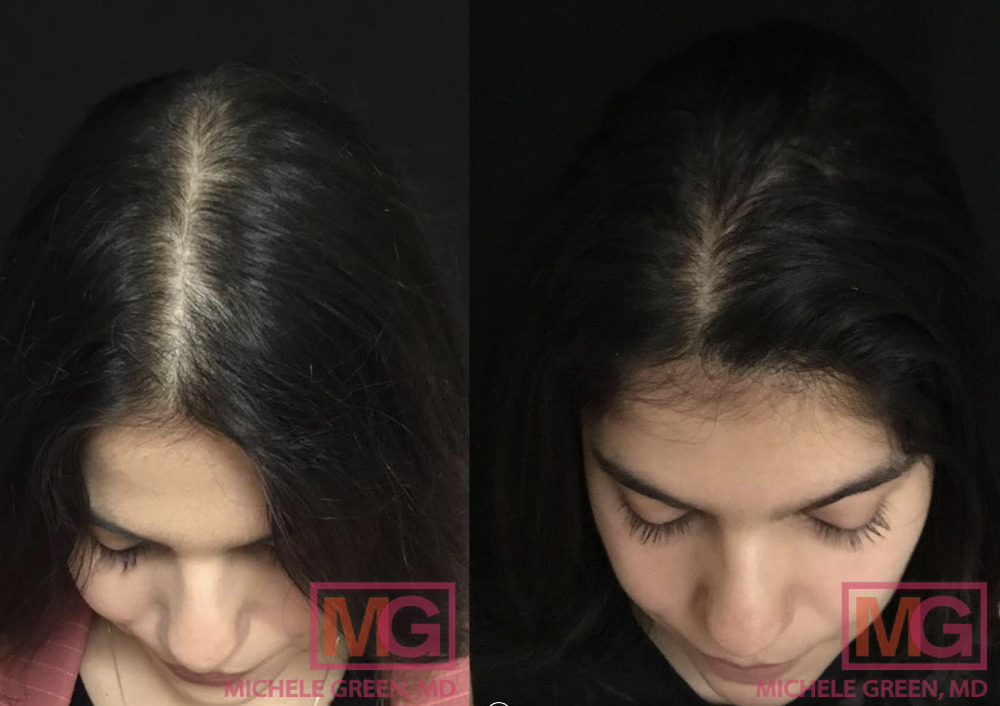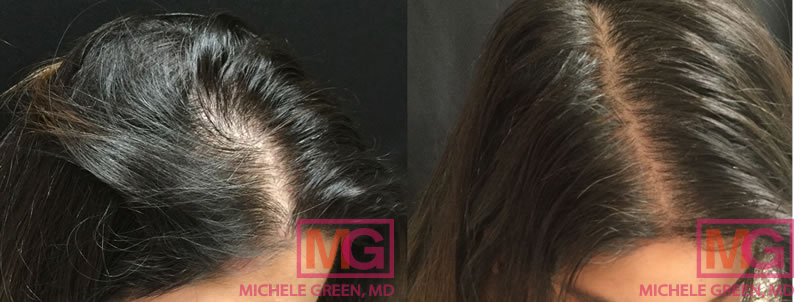PRP Hair Treatment & Hair Loss
Autologous Platelet-Rich Plasma Hair Growth Treatment for Hair Loss
Many people struggle with hair loss today. In fact, according to the International Society of Hair Restoration Surgery, approximately 56 million adults in the United States experience some form of hair loss. Until recently, there were few non-surgical treatments available for hair restoration. Now, thanks to Platelet-Rich Plasma (PRP) hair treatment, patients can reduce hair thinning and shedding while enhancing hair density and growth with minimal downtime. Dr. Michele Green is an internationally renowned expert in cosmetic dermatology and PRP hair restoration in New York City. She has been at the forefront of helping patients regrow hair and treat alopecia with PRP injections, as well as other oral and topical treatments.
Platelet-rich plasma (PRP) is an innovative treatment for hair loss that harnesses the growth factors in your blood to stimulate new hair growth and stop further loss. PRP treatment can effectively address various types of hair loss, including androgenetic alopecia and telogen effluvium. The therapy involves extracting platelet-rich plasma from the patient’s blood, which, once isolated, is then injected into the areas of the scalp affected by hair loss or thinning. The PRP treatment promotes natural hair growth and strengthens hair follicles, encouraging regrowth while preventing loss. This procedure is straightforward and entails minimal downtime and discomfort, making it an ideal choice for patients who are hesitant about surgical options, such as hair transplants. With a series of PRP injections, Dr. Green can help patients achieve thicker, fuller, and healthier hair.
Dr. Michele Green is an internationally renowned, board-certified dermatologist with over two and a half decades of experience providing the world’s most discerning individuals with top non-surgical cosmetic treatment options, including platelet-rich plasma treatment for hair restoration. Dr. Green adopts a holistic approach, tailoring each patient’s treatment plan to best suit their needs and goals. She is consistently recognized as one of New York’s top dermatologists by Castle Connolly, New York Magazine, Super Doctors, and The New York Times for her dedication to her patients and expertise. When you consult with Dr. Green at her private dermatology office in Manhattan’s Upper East Side neighborhood, she collaborates with you to develop a personalized hair loss treatment plan that caters to your specific needs and helps you achieve healthier, thicker hair that lasts.
What is Platelet-Rich Plasma (PRP)?
Platelet-rich plasma is a widely used non-surgical treatment for hair loss and restoration in both men and women. PRP contains a high concentration of platelets, which are abundant in growth factors that support healing and regeneration. PRP treatment is autologous, meaning it utilizes a sample of the patient’s own blood. After the blood is drawn, the sample is placed in a centrifuge to separate the plasma from other blood components (such as red blood cells). When injected into areas of the scalp experiencing hair loss, excessive shedding, or thinning, the PRP enhances the health of hair follicles by improving blood flow to the region and stimulating reparative cells.
PRP is an excellent solution for treating hair loss in both men and women, especially when hair transplant surgery is not an option. The treatment can be performed safely on a monthly basis, depending on the desired level of hair growth. Often, patients undergo a series of treatments followed by regular maintenance sessions to sustain and enhance the results. In addition to addressing hair loss, PRP is also used in medical treatments for musculoskeletal injuries and microneedling procedures for enhanced skin rejuvenation.
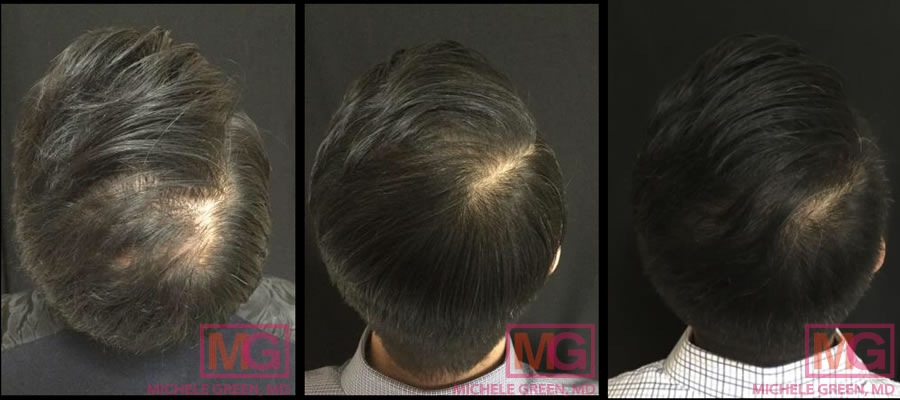
What does PRP do for hair?
Platelet-rich plasma nourishes hair follicles, promotes the transition from the resting phase to the active growth phase, and reduces shedding. It contains proteins essential for accelerated wound healing and tissue regeneration in inactive hair follicles. Within PRP are various intracellular structures, including glycogen (a form of glucose), lysosomes (which break down proteins), and alpha granules (which contain blood clotting and growth factors released during the cell repair process). Growth factors derived from platelet-rich plasma also contribute to cellular differentiation, proliferation, migration, and morphogenesis. Specifically, the growth factors that stimulate hair growth include:
- Platelet-Derived Growth Factor (PDGF) plays a crucial role in the development of blood vessels and cells, aiding in the extension of the anagen phase of hair growth, which may also help prevent further hair loss.
- Vascular Endothelial Growth Factor (VEGF) is involved in the formation of blood vessels and other cells and tissues necessary for hair growth.
- Epidermal Growth Factor (EGF) plays a role in the formation of new cells, blood vessels, and collagen, and it stimulates the anagen phase of hair growth.
- Fibroblast Growth Factor (FGF) stimulates the growth of blood vessels and specialized cells, and it prolongs the anagen phase.
- Transforming Growth Factor Beta (TGF-β) fosters a growth matrix among cells and bone metabolism.
- Insulin-Like Growth Factor (IGF) facilitates cell differentiation, growth, and recruitment in skin, blood vessels, bone, and other tissues.
What types of hair loss does PRP therapy help?
Androgenetic alopecia
Androgenic alopecia, also known as male-pattern hair loss or female-pattern hair loss, is the most common type of hair loss and is largely hereditary. In androgenetic alopecia, the anagen, or growth cycle, shortens, leading to progressively thinner hairs produced by the hair follicles. Androgenic alopecia can affect both men and women and is associated with fluctuations in androgen hormones, particularly dihydrotestosterone. Male-pattern baldness is characterized by a thinning crown and a receding hairline that forms an “M” shape. Female-pattern hair loss typically appears as diffuse thinning and a wider hairline or part. Although androgenic alopecia cannot be prevented, PRP treatment is effective in promoting hair growth in the affected areas. This treatment can be combined with topical or oral medications, such as Minoxidil and Finasteride, to help halt your hair loss and aid in regrowing your hair.
Telogen effluvium
Telogen effluvium is a stress-related hair loss condition that can be acute, meaning the hair loss occurs suddenly, or chronic, meaning the thinning develops gradually over time. This type of hair loss typically arises two to four months after a traumatic event, such as childbirth, severe chronic illness, surgery, exposure to general anesthesia, psychological trauma or anxiety, or diets lacking sufficient protein or medications. During telogen effluvium, a significant number of hairs are prematurely forced into the resting phase, leading to diffuse shedding. Usually, this type of hair loss affects the scalp, but it can occur anywhere on the body. In most cases, once the hair has fallen out and the traumatic event has subsided, regrowth occurs over the next three to six months. PRP is an effective treatment for promoting hair regrowth and accelerating its rejuvenation.
Alopecia areata
Alopecia areata is a hair loss condition characterized by patchy hair loss on the scalp. It is an autoimmune disorder, meaning that the body’s immune system mistakenly attacks its cells. Patients with alopecia areata experience white blood cells that target their hair follicles, leading to a reduction in follicle size and a slowdown in hair growth. Hair may fall out in quarter-sized patches, and the extent of hair loss can range from a few small patches to more severe cases with significant hair loss. This condition is believed to have a genetic component and can develop suddenly, affecting individuals of all ages and genders. While there is no known cure for alopecia areata, many patients typically see full hair regrowth within 12 months. Cortisone injections can effectively reduce the immune response in the affected area. PRP therapy can be used in conjunction with cortisone injections to strengthen the hair follicles and enhance hair rejuvenation and regrowth.
Am I a candidate for PRP Treatment?
A suitable candidate for PRP hair restoration is an individual who exhibits signs of thinning hair or hair loss. Generally, individuals who have recently experienced hair loss or are dealing with early hair loss tend to respond best to PRP hair treatment. PRP therapy is not effective for those who have completely lost hair follicles in a specific area. Additionally, patients may not qualify for PRP therapy if they have an active infection or certain blood disorders. When you meet with Dr. Michele Green in her private NYC dermatology office, she will obtain a comprehensive medical and family history and evaluate your scalp and hair loss to determine if you are a suitable candidate for PRP hair restoration treatment.
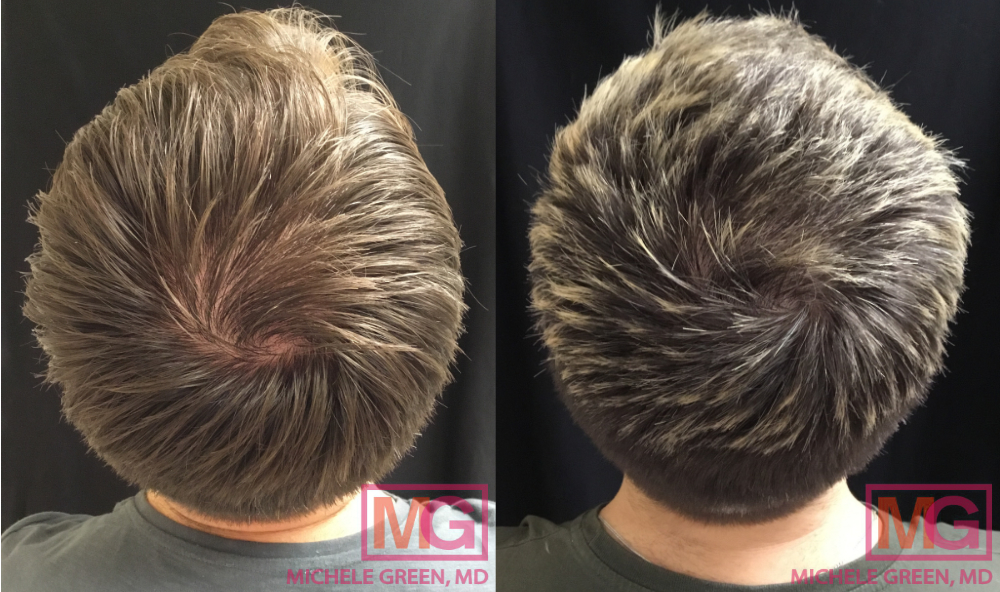
6 months before and after
What to do before PRP hair treatment
One of the advantages of PRP injections for hair loss is the minimal preparation required for the procedure. There are several steps patients can take to ensure their PRP treatment proceeds smoothly. Dr. Green advises all her patients to avoid taking blood-thinning medications or supplements, including Advil, Ibuprofen, Motrin, Aspirin, fish oil, vitamin E, and multivitamins, for one week prior to their PRP injections to prevent excessive oozing from the injection sites during the procedure. Patients should avoid coloring their hair, drinking alcohol, and smoking before the procedure. It is essential to eat something on the day of your PRP injections, both before your appointment and before your blood is drawn. Staying hydrated before your PRP treatment will help make the blood draw easier. When you consult with Dr. Green regarding PRP injections for hair restoration, you will receive the necessary information to prepare for your treatment effectively.
The PRP injection process
The PRP injection process is quick and straightforward. When you arrive at Dr. Green’s office for your PRP appointment, your blood will be drawn and processed in a centrifuge. The PRP will then be separated from the platelet-poor plasma and other blood components. Dr. Green will inject the PRP across the scalp or in targeted areas of hair loss, depending on your specific hair concerns. The entire process takes approximately 30 minutes, from the moment your blood is drawn until the PRP is injected into your scalp, with no downtime required after treatment. An initial series of four PRP treatment sessions, each spaced one month apart, is recommended for optimal restoration results. Throughout your series of PRP treatments, the targeted areas of the scalp may change slightly as hair density increases. Dr. Green will reassess your scalp and hair during each follow-up visit. After the initial series, Dr. Green will check in with you in three months to evaluate your hair regrowth and establish a plan for future maintenance treatments. Many patients undergo semi-annual maintenance PRP treatments to sustain optimal hair restoration results.
What to do after PRP hair treatment
There is minimal downtime after PRP treatment, allowing patients to return to their usual activities quickly. However, there are specific activities that Dr. Green recommends avoiding in the days following the treatment to ensure that the healing process proceeds as planned. First, Dr. Green advises patients not to wash their hair on the day of the treatment; however, they may use shampoo as usual the day after the treatment. Second, Dr. Green suggests that patients refrain from exercising the day after the treatment, although they can resume their regular workouts the next day. Patients should also avoid alcohol, smoking, and hair dyes for three days following the procedure. Lastly, Dr. Green advises against taking blood-thinning medications. Instead of taking Aleve, Motrin, Advil, or Ibuprofen, patients should take Tylenol for any discomfort after PRP injections. When receiving PRP injections from Dr. Green at her private dermatology office in NYC’s Upper East Side neighborhood, she will provide the necessary aftercare information required to achieve the best hair restoration results.
What are the side effects of PRP Treatment?
There are minimal side effects associated with PRP treatment. The most common side effects of hair restoration are swelling and tenderness at or near the injection sites in the treated area. These side effects typically resolve on their own within several days of treatment. Patients are advised to use Tylenol for pain relief before and after PRP treatment instead of Ibuprofen, Motrin, Advil, and Aleve, which are blood thinners and can increase oozing during treatment and worsen swelling afterward. Since PRP is derived from the patient’s blood, there is no risk of an allergic reaction.
When can I expect to see results from a PRP hair treatment?
Results may vary depending on the type and severity of hair loss, the use of oral or topical hair loss medications, the patient’s medical history, and each patient’s desired outcome. For many patients, increased hair thickness and density are often visible several weeks after treatment. Regrowth and optimal results from PRP injections typically appear about 5 to 7 months after treatment.
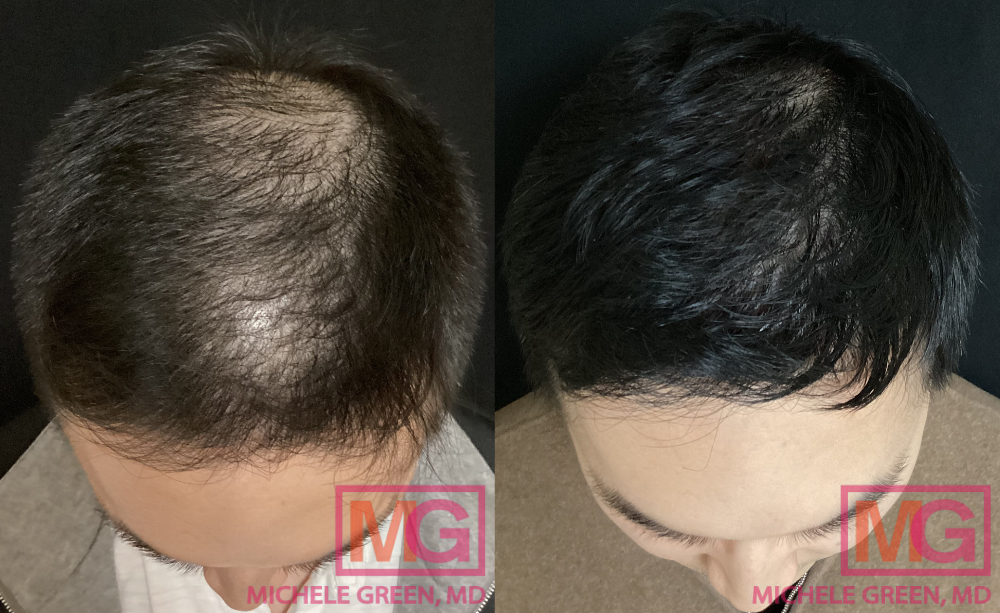
How many PRP sessions are needed for hair?
Patients generally begin with an initial series of four PRP sessions, scheduled one month apart. Results are assessed at the fourth session and again three months later. After this, patients will have maintenance sessions two to four times a year, depending on their progress and desired outcome, to sustain the treatment results. However, the number of recommended PRP sessions may differ based on each patient’s hair condition and aesthetic goals. Dr. Green will utilize her expertise to offer the most effective medical advice, diagnosis, and treatment plan tailored to your specific hair loss and medical history, helping to thicken and regrow your hair.
What other hair restoration treatments are available at a dermatology office?
PRP therapy for hair growth has emerged as an innovative treatment option for patients facing various types of hair loss, including androgenetic alopecia, telogen effluvium, and alopecia areata. However, depending on the type and severity of your hair loss, PRP alone may not be sufficient for hair restoration. Frequently, Dr. Green employs a combination approach to hair loss, utilizing PRP therapy in conjunction with topical and oral medications to achieve optimal hair restoration results, resulting in thicker, healthier-looking hair.
Topical Minoxidil, commonly referred to as Rogaine, is the only FDA-approved topical medication for hair restoration. Minoxidil works to restore inactive hair follicles and keep hairs in the growth phase of the hair cycle. Many dermatologists also prescribe oral Minoxidil off-label for hair loss treatment. While once used as a high blood pressure medication, low-dose oral Minoxidil has been found to increase hair retention and growth and strengthen hair follicles.
Propecia, or Finasteride, is an FDA-approved oral medication for the treatment of male-pattern baldness. Propecia is an alpha-5-reductase inhibitor that reduces the conversion of testosterone into dihydrotestosterone (DHT), an androgen hormone linked to hair follicle miniaturization. Propecia can increase hair thickness and retention. While Propecia is not FDA-approved for use in women, it is commonly prescribed off-label for post-menopausal women.
While not FDA-approved for hair loss, Dutasteride is another oral medication commonly prescribed off-label for treating male-pattern baldness. Dutasteride functions as an alpha-5-reductase inhibitor to lower DHT levels in men. While Propecia only inhibits the type 2 form of 5-alpha-reductase, Dutasteride inhibits both types 1 and 2, potentially enhancing its effectiveness.
Spironolactone is an anti-androgen oral medication used to treat female-pattern Spironolactone is an oral anti-androgen medication used to treat female-pattern hair loss. It regulates the production of DHT and other androgen hormones, helping to reduce hair thinning and loss. This medication is especially beneficial for patients experiencing hair loss related to PCOS. Besides hair restoration, Spironolactone is effective for treating and managing acne breakouts.
Women experiencing androgenetic alopecia may also benefit from oral contraceptives. These medications can regulate androgen hormones to reduce hair thinning and promote hair growth. Hormone replacement therapy (HRT) can also assist patients dealing with hair loss due to menopause. Estrogen plays a crucial role in supporting hair retention and growth. HRT can help replenish estrogen levels lost during menopause, keeping hair in the growth phase and enhancing thickness and density. A board-certified OBGYN can prescribe oral contraceptives and HRT for hair restoration.
The Keravive treatment by HydraFacial is a medical-grade facial designed to improve the health of the scalp and hair follicles. When excess dead skin cells and oils accumulate on the scalp, the resulting inflammation can impede proper hair growth. The Keravive treatment aims to thoroughly cleanse and exfoliate the scalp, utilizing patented vortex technology to gently stimulate increased blood circulation and enhance nutrient flow to the hair follicles. After the scalp is properly cleaned, the Keravive treatment delivers essential growth factors and proteins to hydrate and nourish the hair follicles. Additionally, patients receive a Keravive peptide complex spray to use at home for several weeks following treatment. Patients can undergo a series of three treatments, each spaced one month apart, to achieve optimal results.
PRP for hair loss – 12 months before and after
FAQs about PRP hair restoration treatment
How does PRP help hair growth?
PRP contains platelets rich in growth factors that are essential for tissue healing and regeneration. Key growth factors present in PRP for hair loss include platelet-derived growth factor (PDGF), vascular endothelial growth factor (VEGF), epidermal growth factor (EGF), fibroblast growth factor (FGF), transforming growth factor beta (TGF-β), and insulin-like growth factor (IGF). When injected into areas of the scalp experiencing hair loss, severe shedding, or thinning hair, these growth factors enhance follicle health, improve blood supply to the area, and stimulate reparative cells. This process leads to reduced shedding, an increase in the number and size of hair follicles, and ultimately, new hair growth.
Is PRP treatment FDA-approved?
Platelet-rich plasma is obtained from a sample of the patient’s blood, making it technically classified by the FDA as a biological rather than a drug. Consequently, PRP treatment is not subject to FDA approval before healthcare providers use it. Although the FDA has not officially approved PRP injections, the therapy is FDA-cleared as a safe and effective option for hair restoration.
When will hair loss stop after PRP?
One of the most noticeable benefits of PRP is often a reduction in hair shedding. Many patients notice this effect after just two treatment sessions. Platelet-rich plasma therapy stimulates and sustains natural hair growth by strengthening the hair follicles and increasing the thickness of the hair shafts. Therefore, in addition to promoting hair growth, the treatment also helps prevent future hair loss in the treated area. Multiple sessions may be needed to achieve optimal results.
Will PRP increase hair density?
Yes! Studies have shown that, in addition to stimulating new hair growth and reducing shedding, PRP can also increase the thickness of hair follicles. After a short initial series of PRP treatments, many patients notice their hair becoming thicker, fuller, and denser.
Will PRP regrow hair?
Yes, PRP is extremely beneficial for the hair regrowth process. It can lead to a longer hair growth phase and thicken the hair shaft, resulting in full, dense hair. Since hair growth is slow, it may take at least four months for patients to notice any new growth on the scalp. Additionally, many patients use other hair loss treatments, such as topical minoxidil or oral medications, to enhance their hair growth results. When you consult with board-certified dermatologist Dr. Green at her private NYC office, she will gather a comprehensive medical and family history and physically assess your scalp and hair to determine whether you are a suitable candidate for PRP and which other hair loss treatments may benefit you for optimal hair regrowth.
Is PRP hair treatment permanent?
PRP hair treatment offers patients thicker, fuller, and healthier hair with long-lasting results, though it is generally not a permanent solution for all types of hair loss. Most patients undergo maintenance treatment sessions after their initial PRP injection series to achieve the best results. Dr. Green may suggest that patients return every 3 to 4 months for another series of injections or a single maintenance treatment annually. The permanence of the treatment also varies depending on the condition being treated. For instance, if a patient experiences telogen effluvium, PRP treatment can aid the hair regrowth process within 3 to 6 months. After that period, most patients may not require any further treatment if the hair loss condition has resolved.
PRP to scalp for hair loss – after 3 treatments
Does PRP hair treatment hurt?
Many patients wonder whether PRP hair treatment is painful. Although an expert like Dr. Green can quickly perform PRP injections, the scalp may be sensitive to the procedure. For patients who are sensitive to PRP injections, Dr. Green can prescribe a topical anesthetic to be applied to the affected areas of the scalp one hour before the procedure, helping to minimize potential discomfort associated with the PRP treatment. Following the procedure, patients may experience soreness or redness at the injection site. Nevertheless, these side effects are generally mild and common, and they will typically subside shortly after treatment.
What to avoid after PRP hair treatment
After undergoing a PRP hair treatment, patients should avoid washing their hair, using topical hair products, and engaging in strenuous exercise for 24 hours, as well as refraining from alcohol consumption, smoking, or hair dyes for three days following the treatment. Patients should also continue to avoid blood-thinning medications or supplements, including Advil, Ibuprofen, Motrin, Aspirin, fish oil, vitamin E, and multivitamins, for an additional week. When you receive PRP injections with Dr. Green, she will provide you with a complete list of aftercare recommendations to maximize the results of your hair loss treatment.
Are PRP injections safe?
Absolutely! PRP is a safe and effective hair restoration treatment that strengthens, thickens, and promotes hair growth. There are minimal potential side effects associated with the procedure, as PRP is derived from a sample of the patient’s blood and involves essentially no downtime. The most common side effects include mild swelling and tenderness at the injection sites, which typically resolve on their own shortly after treatment. When you consult with Dr. Green for your hair loss treatment plan, a thorough medical history will be taken to determine if PRP is a suitable and effective hair restoration treatment for you.
Can PRP cause hair loss?
In rare cases, patients may experience telogen effluvium, or hair thinning, as a result of shock following an initial PRP injection. However, this effect subsides following the first PRP treatment. Some patients may also have a delayed response to PRP treatment, where its positive effects become noticeable only after completing several treatments. Patients who experience shedding after PRP treatment may benefit from using a topical or oral hair loss medication in conjunction with PRP to reduce shedding and thinning effectively.
Why is PRP not working for my hair?
Not all patients are suitable candidates for PRP hair restoration. For example, if you have experienced scarring alopecia in the past, PRP injections may not be the most effective hair growth treatment for you. Therefore, it’s crucial to discuss your medical history and have your current hair loss evaluated by Dr. Green during your initial consultation. Dr. Green may order blood tests to identify any underlying causes of your hair loss and ensure you are a good candidate for PRP hair restoration treatment.
Does PRP hair treatment work?
Yes! Multiple studies in the Journal of Cosmetic Dermatology and Aesthetic Plastic Surgery have found that patients suffering from hair loss benefit from PRP injections. The science behind PRP harnesses the proven advantages of autologous growth factors to promote natural regenerative healing and cellular growth. As a result, PRP hair restoration treatment leads to a noticeable local increase in hair follicle count, a prolonged growth phase, and enhanced hair thickness. Research consistently demonstrates the effectiveness of PRP treatment in promoting hair regrowth and reducing hair thinning caused by androgenic alopecia, telogen effluvium, and alopecia areata. For patients who may be hesitant about more intensive procedures, such as hair transplants, the appeal of non-invasive PRP treatment is significant.
How much is PRP hair treatment?
The cost of PRP treatment ultimately varies based on several factors, including your geographic location, the expertise level of your provider, and the number of treatment sessions you choose. Typically, patients undergo an initial series of four PRP treatment sessions, each scheduled one month apart. When you consult with Dr. Green at her private, boutique dermatology office in NYC’s Upper East Side, she will collect a comprehensive medical and family history and evaluate your scalp and hair. Laboratory tests may be requested to identify any underlying factors contributing to hair loss. Depending on the results and Dr. Green’s evaluation, a customized hair loss treatment plan will be created for you, incorporating a combination of interventions best suited to your needs. The total cost of your PRP and hair loss treatments will be determined at that time.
Is PRP for hair loss covered by insurance?
Unfortunately, PRP hair restoration is classified as a cosmetic procedure and is generally not covered by health insurance. It is always advisable to contact your insurance company directly to determine if you have any coverage for the procedure.
How many PRP treatments are needed for hair restoration?
Most patients need an initial series of four PRP treatments, each scheduled about one month apart, to achieve optimal hair regrowth results. It may take some time for hair growth to occur after PRP treatment, and Dr. Green asks her patients to return three months after the final treatment session in the series to evaluate the results. At that time, a fifth PRP treatment may be suggested, depending on Dr. Green’s assessment of your hair regrowth. Many patients receive quarterly, biannual, or annual PRP treatments to maintain their results. Dr. Green will help you establish a personalized timeline for your PRP treatments that is best suited to your individual needs and situation.
Where to get PRP hair treatment
PRP injections must be performed by an experienced medical professional with the necessary training and expertise to provide treatment safely and effectively, such as board-certified dermatologist Dr. Michele Green in New York City. Dr. Green is an internationally renowned expert in dermatology with over twenty-five years of experience and a special interest in hair restoration. Dr. Green has helped some of the world’s most discerning individuals achieve and maintain thicker, fuller, healthier hair that lasts by tailoring their hair loss treatment plans to their unique needs. When you consult with Dr. Green at her private dermatology office in Manhattan’s Upper East Side, she will gather a comprehensive medical and family history, physically evaluate your scalp and hair loss condition, and potentially collect bloodwork or a biopsy for lab tests. Together, you will develop a personalized hair loss treatment plan tailored to your specific needs.
Which is better, PRP or Mesotherapy for hair?
Mesotherapy, like PRP, is a non-invasive cosmetic treatment option for hair restoration. This procedure involves injecting a mixture of vitamins, amino acids, and minerals into the scalp. As a hair loss treatment, Mesotherapy addresses conditions such as androgenetic alopecia by enhancing blood circulation, preventing inflammation, nourishing hair follicles, and reducing the risk of future hair loss. In contrast, PRP contains growth factors and proteins essential for tissue healing, regeneration, and hair follicle health. The high concentration of growth factors in PRP typically produces more comprehensive hair restoration results than those achieved with Mesotherapy. Additionally, PRP treatment has minimal side effects, as the serum is entirely derived from the patient’s blood. While Mesotherapy can offer some benefits for hair regrowth, PRP is preferred by most patients and providers due to its proven safety and effectiveness for hair restoration.
Is PRP hair treatment effective?
Yes! Numerous studies have confirmed the effectiveness of PRP therapy for hair growth. Researchers have found that a series of PRP treatments helps prevent hair loss and thinning while promoting new hair growth in patients with androgenetic alopecia. In a review of clinical trials measuring PRP’s effectiveness against male pattern hair loss, researchers found that PRP injections significantly increased the number of hairs, the thickness of hair follicles, and hair density compared to the control group. Additional studies have shown that, compared to Finasteride, Minoxidil, and stem-cell solutions, 84% of patients who received platelet-rich plasma injections reported a positive change in their hair, and 50% observed a significant decrease in hair loss. Dr. Green has provided PRP treatments for hair restoration at her private dermatology office in New York City for many years, helping men and women worldwide achieve thicker, healthier, and fuller hair.
What is the best treatment for hair loss?
Every individual experiencing hair loss or thinning hair has unique needs and goals regarding treatment for hair growth. Multiple factors can contribute to hair loss, including genetics, hormonal changes, aging, certain medications, underlying health conditions, hair styling practices, illnesses, and other considerations. Depending on the cause of your hair loss, a combination of oral and topical treatments, alongside PRP therapy, may be the most effective approach. Hair loss treatment is often most successful when a personalized combination strategy is utilized. Dr. Green will collaborate with you to develop a tailored treatment plan that includes PRP therapy and prescription medications such as oral or topical Minoxidil, Finasteride (Propecia), Dutasteride, or Spironolactone, all aimed at helping you achieve thicker, fuller, and healthier hair that lasts.
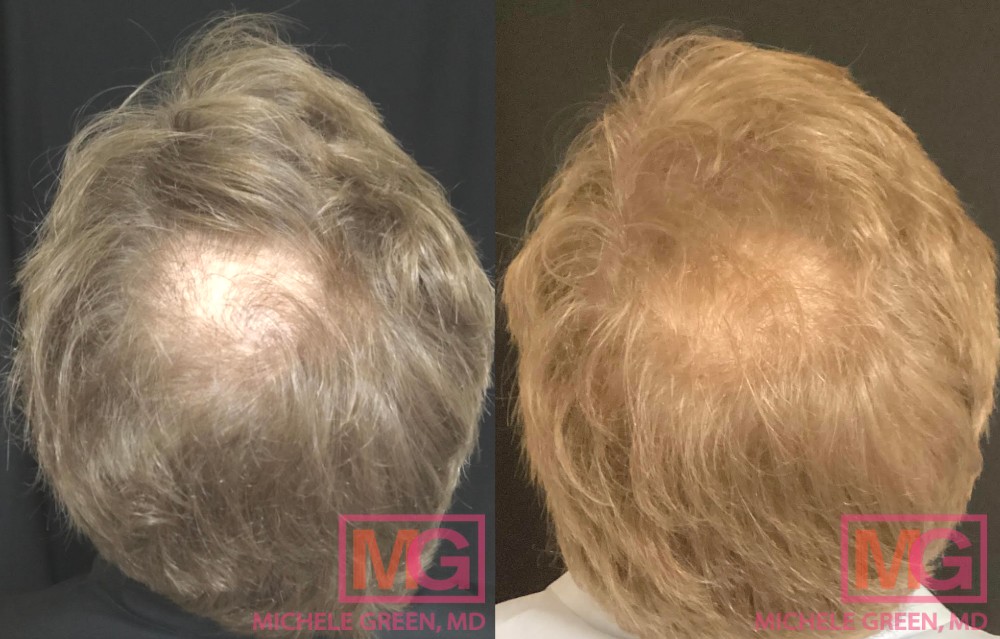
How do I get started with PRP treatment for hair restoration today?
Hair loss and thinning hair are very common issues that can be incredibly frustrating for both men and women, often leading to feelings of self-consciousness and low self-esteem. Platelet-rich plasma (PRP) treatment provides patients with a non-invasive option for addressing hair loss. PRP hair loss treatment uses the high concentration of growth factors in one’s blood to stimulate new hair growth and prevent further hair loss. Dr. Michele Green was one of the first board-certified dermatologists in NYC to skillfully combine PRP injections with other hair restoration treatment options to promote thicker, healthier-looking hair. If you are experiencing hair loss or thinning and are interested in PRP hair restoration treatment, Dr. Green is here to help.
Dr. Michele Green is an internationally renowned board-certified dermatologist with over 25 years of experience providing her patients from around the globe with the best non-invasive treatment options available, including PRP injections for hair restoration. Castle Connolly, New York Magazine, Super Doctors, and The New York Times consistently recognize Dr. Green as one of the best dermatologists in NYC for her dedication to her patients and expertise. If you are looking for where to get PRP injections for hair loss, consult with Dr. Green today. During your consultation at her private dermatology office in the Upper East Side neighborhood of Manhattan, she will collaborate with you to create a customized hair loss treatment plan tailored to your needs and goals. If you are facing thinning hair or hair loss, you can schedule a consultation with Dr. Green in New York City by calling 212-535-3088 or contacting us online today.
 212-535-3088
212-535-3088 